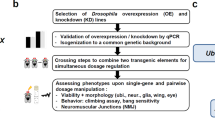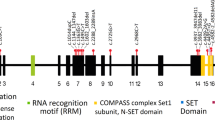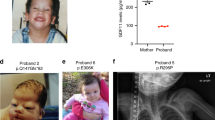Abstract
The genetics underlying autism spectrum disorder (ASD) are complex. Approximately 3–5% of ASD cases arise from maternally inherited duplications of 15q11.2-q13.1, termed Duplication 15q syndrome (Dup15q). 15q11.2-q13.1 includes the gene UBE3A which is believed to underlie ASD observed in Dup15q syndrome. UBE3A is an E3 ubiquitin ligase that targets proteins for degradation and trafficking, so finding UBE3A substrates and interacting partners is critical to understanding Dup15q ASD. In this study, we take an unbiased genetics approach to identify genes that genetically interact with Dube3a, the Drosophila melanogaster homolog of UBE3A. We conducted an enhancer/suppressor screen using a rough eye phenotype produced by Dube3a overexpression with GMR-GAL4. Using the DrosDel deficiency kit, we identified 3 out of 346 deficiency lines that enhanced rough eyes when crossed to two separate Dube3a overexpression lines, and subsequently identified IA2, GABA-B-R3, and lola as single genes responsible for rough eye enhancement. Using the FlyLight GAL4 lines to express uas-Dube3a + uas-GFP in the endogenous lola pattern, we observed an increase in the GFP signal compared to uas-GFP alone, suggesting a transcriptional co-activation effect of Dube3a on the lola promoter region. These findings extend the role of Dube3a/UBE3A as a transcriptional co-activator, and reveal new Dube3a interacting genes.
Similar content being viewed by others
Introduction
Autism spectrum disorder (ASD) has a prevalence of 1 in 681, and is characterized by social communication deficits and repetitive behaviors2. While the underlying genetic causes of autism are complex, recurrent copy number variants associated with ASD can provide insight into the genetic mechanism as they are consistently observed at high rates among ASD individuals3,4,5,6. One such disorder results from maternally derived duplications of chromosome 15q11.2-q13.1, termed Duplication 15q (Dup15q) syndrome and the majority of Dup15q individuals meet the criteria for ASD7. A single gene located within 15q11.2-q13.1, the E3 ubiquitin ligase UBE3A, has been implicated in driving ASD features of Dup15q8,9. Identification of UBE3A substrates and interacting proteins, however, has been a difficult task10.
Using the GAL4/UAS system11, our lab has constructed a Dup15q syndrome model in Drosophila melanogaster through overexpression of Dube3a (the fly UBE3A homolog) to investigate molecular consequences of elevated levels of Dube3a in the fly nervous system. This study supplements our previous proteomics screen12 by taking an unbiased genetics approach to identify genes that interact with Dube3a. Here, we performed an enhancer/suppressor screen, using a rough eye phenotype produced by over-expression of Dube3a with GMR-GAL4, to identify new Dube3a interacting genes. Using the DrosDel deficiency kit that covers 65.2% of the fly genome13, and subsequent uas-RNAi lines, we found three new Dube3a interacting genes: GABA-B-R3, IA2, and lola.
Results
GABA-B-R3, IA2, and lola enhance the GMR > Dube3a rough eye phenotype
We utilized two GMR > Dube3a lines in this screen that were previously characterized to identify modifiers of the rough eye phenotype14. The line GMR > Dube3a45 has moderate Dube3a overexpression that causes a mild rough eye phenotype, while GMR > Dube3a27 has higher Dube3a expression levels and causes a more severe eye phenotype with underlying necrosis. Out of the 346 DrosDel lines, we found that Df(2 L)ED62, Df(2 L)ED105, and Df(2 R)ED2076 enhanced rough eyes when crossed to both GMR > Dube3a45 and GMR > Dube3a27. Next we used a combination of smaller deficiency lines eliminating smaller segments of the genome within each DrosDel line and uas-RNAi lines to identify the specific genes within each region that, when knocked down, enhanced rough eyes produced by Dube3a overexpression (Table 1). We found that expression of RNAi for GABA-B-R3, IA2, and lola enhanced rough eyes in both GMR > Dube3a45 and GMR > Dube3a27, yet RNAi expression for these three genes alone had no effect on eye morphology (Fig. 1). These experiments suggest that Dube3a interacts genetically with GABA-B-R3, IA2, and lola as knockdown of these genes enhances the rough eye produced by Dube3a overexpression.
Identification of enhancers of the rough eye phenotype generated by Dube3a overexpression with GMR-GAL4. The first column represents control fly eyes, indicating the mild rough eye phenotype generated with GMR > Dube3a45 (A) and the severe rough eye phenotype with GMR > Dube3a27 (E). Columns 2–4 are representative images of eyes of the enhancement observed with GABA-B-R3-RNAi (B,F), IA2-RNAi (C,G), and lola-RNAi (D,H), respectively. Note the increase in necrosis observed in the RNAi lines crossed to GMR > Dube3a27 (E–H). No rough eye phenotypes were observed with the GMR > TRiP-Control line or any uas-RNAi line alone (I–L).
Overexpression of Dube3a in the Endogenous lola Expression Pattern Enhances GFP Reporter Signal
Next, we used the FlyLight GAL4 collection15 to express Dube3a in the endogenous pattern of genes identified as Dube3a interactors with a GFP reporter. Each of these fly lines was generated by taking a small segment of DNA that lies upstream of the gene of interest and using it to control the expression of the GAL4 protein. When we expressed GFP + Dube3a in the pattern of lola with the line 49389-lola-GAL4 we observed a marked increase in the GFP signal in the optic lobe compared to GFP alone (Fig. 2A). However, when we expressed GFP + Dube3a in the patterns of GABA-B-R3 we observed no appreciable difference between GFP alone and Dube3a + GFP signals (Fig. 2B), and no FlyLight GAL4 lines were available for IA2. These data suggest that Dube3a interacts with the DNA sequences upstream of lola, potentially through a transcriptional co-activation mechanism.
Increased expression of the GFP reporter in 49389-lola > GFP + Dube3a flies. (A) Expression of the GFP reporter with 49389-lola > GFP revealed a relatively diffuse expression pattern throughout the fly optic lobe with some expression in the mushroom body (left). In 49389-lola > GFP + Dube3a flies we observed a dramatic increase in GFP levels, particularly cells in the optic lobe (right). (B) Expression of the GFP reporter with or without Dube3a in the pattern of GABA-B-R3 with 39924-GABA-B-R3-GAL4 revealed no observable differences between GFP alone (left) and GFP + Dube3a (right). Scale bar is 100 µm.
Discussion
The primary function of the UBE3A E3 ligase is to identify and ubiquitinate substrate proteins16,17. The identification of Dube3a/UBE3A interacting partners, however, has been proven to be a difficult task. One hurdle to identifying UBE3A substrates may be due the transient nature of the interaction between UBE3A and its target protein. In this study we took an unbiased genetics approach using the tractable model organism Drosophila melanogaster and identified IA2, GABA-B-R3, and lola as genetic interactors with Dube3a.
The gene IA2 encodes a receptor protein tyrosine phosphatase that facilitates secretion of insulin-like peptides in Drosophila18, and insulin signaling is important for proper eye development19. It is possible that in a Dube3a overexpression background, perturbation of insulin signaling through IA2 knockdown further impairs eye development, suggesting that Dube3a interacts with proteins involved in insulin signaling pathways. GABA-B-R3 encodes for a metabotropic GABA receptor that displays a unique expression profile compared to other Drosophila metabotropic GABA receptors20. GABA acts as an inhibitory neurotransmitter at GABA-B-R3 receptors through Go G-protein coupling and regulates circadian rhythm behavior21. Aside from the role of GABA-B-R3 in circadian rhythms, the function of GABA-B-R3 is relatively unknown. How Dube3a and GABA-B-R3 interact in the eye is unclear, however our data suggests that Dube3a interacts with the GABAergic system or G-protein coupled receptor function. Lola is a transcriptional repressor and subsets of lola-dependent genes are involved in eye development, cell death, and actin cytoskeleton regulation22. We previously demonstrated that Dube3a regulates the actin cytoskeleton12, implying that actin cytoskeleton disruption may play a role in the rough eye enhancement phenotype. While IA2 has the strong human ortholog PTPRN with an 8/12 DIOPT score23, GABA-B-R3 and lola do not have clear human orthologs. Nonetheless, insights into the basic biology of and the nature of interactions between the identified genes and Dube3a can still provide insight into the function of Dube3a/UBE3A.
We observed an increase in GFP signal in 49389-lola > GFP + Dube3a flies compared to 49389-lola > GFP alone flies. It is unlikely that Dube3a is acting on the UAS promoter region of GFP because the same GFP construct was used in both the lola-GAL4 and GABA-B-R3-GAL4 experiments. We only observed increased GFP expression with lola-GAL4 (Fig. 2). Therefore, we hypothesize that the increased GFP signal is due to the transcriptional co-activation function of Dube3a, a phenomenon previously reported by our lab and others24,25,26, but largely unexplored. Our working model is that in 49389-lola > GFP flies, the GAL4 protein binds to the uas-GFP sequence, driving expression of the GFP reporter. However, in 49389-lola > GFP + Dube3a flies, the GAL4 protein binds to both the uas-GFP sequence and the uas-Dube3a sequence, causing both GFP and Dube3a to be expressed. If Dube3a is acting as a transcriptional co-activator, Dube3a could be looping back to the 49389-lola-GAL4 sequence and driving expression of more GAL4 protein. The increase in GAL4 protein is then further driving expression of GFP, resulting in a feedback loop causing the increased GFP fluorescence observed in 49389-lola > GFP + Dube3a flies. An alternative mechanism could be the Dube3a-dependent degradation of a region specific lola repressor that leads to increased GFP expression, and this repressor is not present at the GABA-B-R3 locus. While these hypotheses remain to be tested in further detail, the data presented here serves as a solid starting point since the DNA sequence used to drive GAL4 expression in the 49389-lola-GAL4 line is known.
In conclusion, our lab utilized an unbiased enhancer/suppressor screen and identified GABA-B-R3, IA2, and lola as Dube3a interacting genes. Dube3a appears to have transcriptional co-activation activity within a subset of lola expressing cells which remains to be investigated further.
Materials and Methods
Fly Stocks
Flies were reared at 25 °C on standard Drosophila corn meal media. GMR-GAL4, 49389-lola-GAL4, the DrosDel Deficiency Kit, uas-lola-RNAi, uas-IA2-RNAi, and uas-GABABR3-RNAi, along with other uas-RNAi lines were obtained from the Bloomington Drosophila Stock Center (for complete list of stocks, see Supplemental Table 1). The uas-Dube3a lines used in these experiments were described previously14. The line uas-Dube3a45 has moderate Dube3a expression and produces a mild rough eye phenotype when crossed to GMR-GAL4, while uas-Dube3a27 line has higher Dube3a overexpression with GMR-GAL4 and produces a severe rough eye phenotype with underlying necrosis14. Stock lines were made consisting of GMR-GAL4 + uas-Dube3a45 or GMR-GAL4 + uas-Dube3a27, which were subsequently crossed to DrosDel deficiency lines. The uas-GFP lines was a gift from Dr. Cynthia Hughes.
Enhancer Suppressor Screen
Male flies from the DrosDel deficiency kit were crossed to virgin female GMR-GAL4 + uas-Dube3a45 and GAL4 + uas-Dube3a27 flies at 25 °C. 3–5 days after eclosion, eyes were compared to GMR > Dube3a45 and GMR > Dube3a27 alone. Enhancement was defined as an increase in the following parameters: eye roughness, fusion of ommatidia, and/or underlying necrosis (yellow and black color). Any DrosDel line identified as an enhancer of the rough eye phenotype caused by Dube3a overexpression was independently scored by a second observer for confirmation. The flybase genome browser was used to identify secondary deficiencies and genes within each region that were subsequently tested for enhancement of rough eyes with uas-RNAi lines for individual genes located within the region. Images were captured on a PowerShot S50 (Canon) camera mounted to a Leica L2 compound dissecting microscope and processed with PhotoShop (Adobe). Adjustments to brightness and contrast were consistent across all images.
Fly Brain Dissection and Imaging
3–5 day old flies were briefly anesthetized with CO2, heads were removed, and brains were dissected in phosphate buffered saline (PBS). Brains were fixed in 4% formaldehyde, washed with PBS, and mounted on glass slides with Vectashield Mounting media (Vector Labs H-1200). Images were acquired on a Zeiss 710 confocal microscope (Zeiss) located in the UTHSC Neuroscience Institute Imaging Core at 1024 × 1024 resolution with the detector gain and offset optimized to use the full 12-bit linear range. Microscope settings remained constant between control and experimental groups. GFP was excited using a 488 nm laser and emission was collected at 493–569 nm. Z-sections were acquired at 1 µm optical section thickness through the entirety of the brain. Images were acquired and z-stacks were transformed to maximum intensity projections using ZEN software (Zeiss).
Data Availability
All data generated during this study are included in this manuscript, the supplemental materials, or can be made available from the corresponding author upon reasonable request.
References
Christensen, D. L. et al. Prevalence and Characteristics of Autism Spectrum Disorder Among Children Aged 8 Years–Autism and Developmental Disabilities Monitoring Network, 11 Sites, United States, 2012. MMWR Surveill Summ 65, 1–23, https://doi.org/10.15585/mmwr.ss6503a1 (2016).
American Psychiatric Association. Diagnostic and Statistical Manual of Mental Disorders: DSM-5.5th edn. 5th edn (2013).
Sebat, J. et al. Strong association of de novo copy number mutations with autism. Science 316, 445–449, https://doi.org/10.1126/science.1138659 (2007).
Pinto, D. et al. Functional impact of global rare copy number variation in autism spectrum disorders. Nature 466, 368–372, https://doi.org/10.1038/nature09146 (2010).
Moreno-De-Luca, D. et al. Using large clinical data sets to infer pathogenicity for rare copy number variants in autism cohorts. Mol Psychiatry 18, 1090–1095, https://doi.org/10.1038/mp.2012.138 (2013).
Noh, H. J. et al. Network topologies and convergent aetiologies arising from deletions and duplications observed in individuals with autism. PLoS Genet 9, e1003523, https://doi.org/10.1371/journal.pgen.1003523 (2013).
Finucane, B. M. et al. In GeneReviews(R) (eds R. A. Pagon et al.) (2016).
Hogart, A., Wu, D., LaSalle, J. M. & Schanen, N. C. The comorbidity of autism with the genomic disorders of chromosome 15q11.2-q13. Neurobiol Dis 38, 181–191, https://doi.org/10.1016/j.nbd.2008.08.011 (2010).
Urraca, N. et al. The interstitial duplication 15q11.2-q13 syndrome includes autism, mild facial anomalies and a characteristic EEG signature. Autism Res 6, 268–279, https://doi.org/10.1002/aur.1284 (2013).
LaSalle, J. M., Reiter, L. T. & Chamberlain, S. J. Epigenetic regulation of UBE3A and roles in human neurodevelopmental disorders. Epigenomics 7, 1213–1228, https://doi.org/10.2217/epi.15.70 (2015).
Duffy, J. B. GAL4 system in Drosophila: a fly geneticist’s Swiss army knife. Genesis 34, 1–15, https://doi.org/10.1002/gene.10150 (2002).
Jensen, L., Farook, M. F. & Reiter, L. T. Proteomic profiling in Drosophila reveals potential Dube3a regulation of the actin cytoskeleton and neuronal homeostasis. PLoS One 8, e61952, https://doi.org/10.1371/journal.pone.0061952 (2013).
Cook, R. K. et al. The generation of chromosomal deletions to provide extensive coverage and subdivision of the Drosophila melanogaster genome. Genome Biol 13, R21, https://doi.org/10.1186/gb-2012-13-3-r21 (2012).
Reiter, L. T., Seagroves, T. N., Bowers, M. & Bier, E. Expression of the Rho-GEF Pbl/ECT2 is regulated by the UBE3A E3 ubiquitin ligase. Hum Mol Genet 15, 2825–2835, https://doi.org/10.1093/hmg/ddl225 (2006).
Pfeiffer, B. D. et al. Tools for neuroanatomy and neurogenetics in Drosophila. Proc Natl Acad Sci USA 105, 9715–9720, https://doi.org/10.1073/pnas.0803697105 (2008).
Kim, H. C. & Huibregtse, J. M. Polyubiquitination by HECT E3s and the determinants of chain type specificity. Mol Cell Biol 29, 3307–3318, https://doi.org/10.1128/MCB.00240-09 (2009).
Zheng, N. & Shabek, N. Ubiquitin Ligases: Structure, Function, and Regulation. Annu Rev Biochem, https://doi.org/10.1146/annurev-biochem-060815-014922 (2017).
Kim, J. et al. Drosophila ia2 modulates secretion of insulin-like peptide. Comp Biochem Physiol A Mol Integr Physiol 151, 180–184, https://doi.org/10.1016/j.cbpa.2008.06.020 (2008).
Huang, H. et al. PTEN affects cell size, cell proliferation and apoptosis during Drosophila eye development. Development 126, 5365–5372 (1999).
Mezler, M., Muller, T. & Raming, K. Cloning and functional expression of GABA(B) receptors from Drosophila. Eur J Neurosci 13, 477–486 (2001).
Dahdal, D., Reeves, D. C., Ruben, M., Akabas, M. H. & Blau, J. Drosophila pacemaker neurons require g protein signaling and GABAergic inputs to generate twenty-four hour behavioral rhythms. Neuron 68, 964–977, https://doi.org/10.1016/j.neuron.2010.11.017 (2010).
Gates, M. A., Kannan, R. & Giniger, E. A genome-wide analysis reveals that the Drosophila transcription factor Lola promotes axon growth in part by suppressing expression of the actin nucleation factor Spire. Neural Dev 6, 37, https://doi.org/10.1186/1749-8104-6-37 (2011).
Wang, J. et al. MARRVEL: Integration of Human and Model Organism Genetic Resources to Facilitate Functional Annotation of the Human Genome. Am J Hum Genet 100, 843–853, https://doi.org/10.1016/j.ajhg.2017.04.010 (2017).
Nawaz, Z. et al. The Angelman syndrome-associated protein, E6-AP, is a coactivator for the nuclear hormone receptor superfamily. Mol Cell Biol 19, 1182–1189 (1999).
Ferdousy, F. et al. Drosophila Ube3a regulates monoamine synthesis by increasing GTP cyclohydrolase I activity via a non-ubiquitin ligase mechanism. Neurobiol Dis 41, 669–677, https://doi.org/10.1016/j.nbd.2010.12.001 (2011).
El Hokayem, J. & Nawaz, Z. E6AP in the brain: one protein, dual function, multiple diseases. Mol Neurobiol 49, 827–839, https://doi.org/10.1007/s12035-013-8563-y (2014).
Acknowledgements
Stocks obtained from the Bloomington Drosophila Stock Center (NIH P40OD018537) were used in this study. This work was supported by a fellowship from the Dup15q Alliance awarded to KAH and R01NS059902 to LTR.
Author information
Authors and Affiliations
Contributions
Study design: K.A.H. and L.T.R. Experimentation: K.A.H. and A.M. Data analysis: K.A.H., A.M. and L.T.R. Manuscript composition and editing: K.A.H. and L.T.R.
Corresponding author
Ethics declarations
Competing Interests
The authors declare no competing interests.
Additional information
Publisher’s note: Springer Nature remains neutral with regard to jurisdictional claims in published maps and institutional affiliations.
Supplementary information
Rights and permissions
Open Access This article is licensed under a Creative Commons Attribution 4.0 International License, which permits use, sharing, adaptation, distribution and reproduction in any medium or format, as long as you give appropriate credit to the original author(s) and the source, provide a link to the Creative Commons license, and indicate if changes were made. The images or other third party material in this article are included in the article’s Creative Commons license, unless indicated otherwise in a credit line to the material. If material is not included in the article’s Creative Commons license and your intended use is not permitted by statutory regulation or exceeds the permitted use, you will need to obtain permission directly from the copyright holder. To view a copy of this license, visit http://creativecommons.org/licenses/by/4.0/.
About this article
Cite this article
Hope, K.A., McGinn, A. & Reiter, L.T. A genome-wide enhancer/suppressor screen for Dube3a interacting genes in Drosophila melanogaster. Sci Rep 9, 2382 (2019). https://doi.org/10.1038/s41598-019-38663-y
Received:
Accepted:
Published:
DOI: https://doi.org/10.1038/s41598-019-38663-y
Comments
By submitting a comment you agree to abide by our Terms and Community Guidelines. If you find something abusive or that does not comply with our terms or guidelines please flag it as inappropriate.





